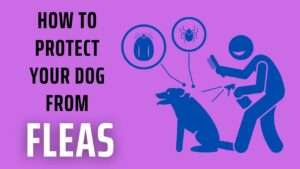Allergies in dogs are a common and often misunderstood condition that can significantly impact a dog’s quality of life.
From environmental triggers to food sensitivities, allergies can manifest in various ways, affecting a dog’s skin, digestive system, and respiratory health.
Let’s unravel the complexities of allergies in dogs, exploring their causes, symptoms, diagnosis, treatment options, and management strategies.
Contents Overview
What is an Allergy?
An allergy is an abnormal immune response to a substance (allergen) that is typically harmless to most individuals.
Types of Allergies
Let’s unravel the complexities of allergies in dogs, exploring their causes, symptoms, diagnosis, treatment options, and management strategies.
1. Food Allergies
Food allergy is the most common form. Dogs can develop allergic reactions to certain ingredients in their diet. Common food allergens include beef, chicken, dairy, wheat, soy, and corn.
2. Environmental Allergies (Atopy)
Environmental factors such as pollen, mold, dust mites, and other airborne allergens can trigger allergic reactions in dogs. These allergies are often seasonal.
3. Flea Allergy Dermatitis (FAD)
Fleas aren’t just a nuisance; they can cause allergic reactions in dogs. Some canines are hypersensitive to flea saliva, leading to severe itching and discomfort. It’s called Flea Allergy Dermatitis (FAD)
4. Contact Allergies
Contact allergy in dogs occurs when their skin reacts to certain substances upon contact, resulting in irritation or allergic reactions. These can include fabrics, cleaning products, or certain plants.
5. Drug Allergies
Drug allergy in dogs occurs when their bodies react adversely to specific medications, leading to allergic reactions or other adverse effects. It may include antibiotics, vaccines, or flea preventatives. These reactions can range from mild to severe and require immediate attention.
Causes of Allergies in Dogs
1. Common Allergens
Dogs can be allergic to various substances present in their environment, food, or even within their own bodies. Some of the most common allergens include:
- Pollen: Pollen from grasses, trees, and weeds can trigger seasonal allergies in dogs.
- Dust Mites: These microscopic creatures thrive in bedding, carpets, and upholstery, often causing allergic reactions.
- Mold: Mold spores, commonly found in damp areas, can provoke allergies in susceptible dogs.
- Fleas: Flea saliva is a potent allergen, causing allergic reactions in dogs who are sensitive to it.
- Food: Ingredients like beef, chicken, dairy, wheat, and soy are frequent culprits of food allergies in dogs.
2. Genetic Predisposition
Just like humans, genetics play a significant role in a dog’s susceptibility to allergies. Certain breeds are more prone to developing allergies than others.
Breeds such as Bulldogs, Boxers, Golden Retrievers, and Terriers are known to have a higher predisposition to allergies.
3. Environmental Factors
Environmental factors can exacerbate allergic reactions in dogs. These factors may include:
- Seasonal Changes: Pollen levels fluctuate with the seasons, leading to seasonal allergies in dogs.
- Indoor Air Quality: Poor indoor air quality due to dust, mold, or other pollutants can worsen allergic symptoms.
- Exposure to Chemicals: Contact with certain chemicals, such as cleaning products or pesticides, can trigger allergies in dogs.
4. Immune System Dysfunction
An overactive or weakened immune system can contribute to the development of allergies in dogs. When the immune system identifies harmless substances as threats, it initiates an allergic response, leading to symptoms like itching, sneezing, and inflammation.
5. Age of Onset
Allergies in dogs can manifest at any age, but they often develop early in life. Some dogs may outgrow allergies, while others may experience worsening symptoms over time.
6. Previous Health Conditions
Dogs with pre-existing health conditions, such as skin infections or autoimmune disorders, may be more susceptible to developing allergies. These conditions can weaken the skin barrier, making it easier for allergens to penetrate and trigger a reaction.
7. Diet and Nutrition
A dog’s diet can influence their susceptibility to allergies. Poor-quality or highly processed foods may contain additives and preservatives that exacerbate allergic symptoms. Additionally, food sensitivities can develop over time, leading to allergic reactions to certain ingredients.
Symptoms of Allergies in Dogs
A- Skin Symptoms
- Itching (Pruritus): Dogs with allergies often exhibit intense scratching, licking, or chewing of the skin, particularly in areas such as the paws, ears, belly, and groin.
- Redness and Inflammation: Allergic reactions can cause the skin to become red, inflamed, and irritated, with the possible development of hot spots or rashes.
- Hair Loss: Chronic scratching or chewing can lead to hair loss (alopecia) and skin lesions in affected areas.
B- Respiratory Symptoms
- Sneezing and Coughing: Dogs with respiratory allergies may experience sneezing fits, coughing, or wheezing, especially when exposed to airborne allergens such as pollen or dust.
- Nasal Discharge: Allergic rhinitis can cause nasal discharge or congestion in dogs, similar to human hay fever symptoms.
C- Gastrointestinal Symptoms
- Vomiting and Diarrhea: Food allergies can manifest as gastrointestinal upset, resulting in vomiting, diarrhea, or soft stools in affected dogs.
- Flatulence and Abdominal Discomfort: Some dogs may exhibit signs of bloating, flatulence, or discomfort after consuming allergenic foods.
Diagnosis of Allergies in Dogs
Diagnosing allergies in dogs requires a comprehensive approach that may involve various tests and examinations.
Here’s how veterinarians typically identify the culprit behind your dog’s allergic reactions:
1- Physical Examination
Your vet will conduct a thorough physical examination to assess your dog’s overall health and examine any skin lesions or signs of irritation.
2- Review of Medical History
Providing details about your dog’s symptoms and any recent changes in their environment or diet can offer valuable clues to the underlying cause.
3- Allergy Testing
A- Skin Prick Test: Similar to human allergy tests, this involves injecting small amounts of potential allergens under the skin and observing the reaction.
B- Intradermal Test: A more detailed skin test where small amounts of allergens are injected into the skin and observed for reactions.
C- Blood Test (Serologic Testing): This measures the levels of antibodies in the blood in response to specific allergens.
4- Elimination Diet Trial
If food allergies are suspected, your vet may recommend an elimination diet trial. This involves feeding your dog a novel protein and carbohydrate source for a set period while monitoring for improvements in symptoms.
5- Fecal Examination
In cases where gastrointestinal issues are present, a fecal examination may be conducted to rule out parasites or other underlying causes.
Treatment Options for Allergies in Dogs
Addressing allergies in dogs often involves a combination of strategies aimed at identifying and avoiding triggers, managing symptoms, and sometimes, addressing the underlying immune system dysfunction.
1- Identifying and Avoiding Allergens
Conduct allergy testing: Allergy testing can help identify specific allergens that trigger your dog’s symptoms, whether they are environmental or food-related.
Environmental control: Minimize exposure to environmental allergens by keeping your home clean, using air purifiers, and avoiding outdoor activities during peak allergy seasons.
Dietary changes: Switching to hypoallergenic or limited-ingredient diets can help identify and eliminate food allergens.
2- Medications
Antihistamines: Over-the-counter or prescription antihistamines can help alleviate itching and other allergy symptoms in dogs.
Corticosteroids: These anti-inflammatory medications can provide rapid relief from severe allergic reactions but should be used cautiously due to potential side effects with long-term use.
Immunosuppressive drugs: In cases of severe allergies, medications that suppress the immune system’s response, such as cyclosporine or oclacitinib, may be prescribed.
3- Topical Treatments
Medicated shampoos: Bathing your dog with medicated shampoos containing soothing ingredients like oatmeal or hydrocortisone can help alleviate skin irritation.
Topical ointments: Prescription ointments or sprays may be recommended to treat localized areas of inflammation or infection.
4- Immunotherapy (Allergy Shots)
Allergy shots, or immunotherapy, involve administering small doses of allergens to desensitize the immune system over time. This treatment is tailored to your dog’s specific allergens identified through allergy testing.
Management Strategies for Allergies in Dogs
A- Regular Veterinary Monitoring
Schedule routine check-ups with a veterinarian to monitor the dog’s response to treatment, adjust medications or dietary recommendations as needed, and address any new or worsening symptoms.
B- Allergen Avoidance
Identify and avoid known allergens whenever possible.
This may involve modifying the dog’s environment, such as using hypoallergenic bedding or eliminating specific ingredients from their diet.
C- Maintain Skin and Coat Health
Regular grooming and bathing can help remove allergens from the dog’s skin and coat, reducing the risk of allergic reactions.
Use gentle, hypoallergenic shampoos and conditioners to soothe irritated skin and maintain moisture balance.
D- Monitor for Secondary Infections
Allergic skin conditions can predispose dogs to secondary bacterial or yeast infections.
Watch for signs of skin redness, odor, discharge, or increased itching, as these may indicate an underlying infection requiring veterinary attention.
E- Consider Alternative Therapies
Some dog owners explore alternative therapies such as acupuncture, herbal supplements, or essential oils to complement traditional treatments for allergies.
However, it’s essential to consult with a veterinarian before trying any new therapies to ensure they are safe and effective for your dog.
F- Educate Yourself
Educate yourself about your dog’s specific allergies and treatment options.
Understanding the triggers and management strategies can help you advocate for your dog’s health and well-being and make informed decisions about their care.
Bottom Line
Allergies in dogs are a multifaceted and often challenging condition to manage.
By understanding the causes, symptoms, diagnosis, treatment options, and management strategies for allergies, dog owners can provide their furry companions with the support and care they need to thrive despite this complex condition.
If you suspect your dog is suffering from allergies, seek veterinary guidance for an accurate diagnosis and tailored treatment plan to address your dog’s specific needs and improve their quality of life.



































+ There are no comments
Add yours